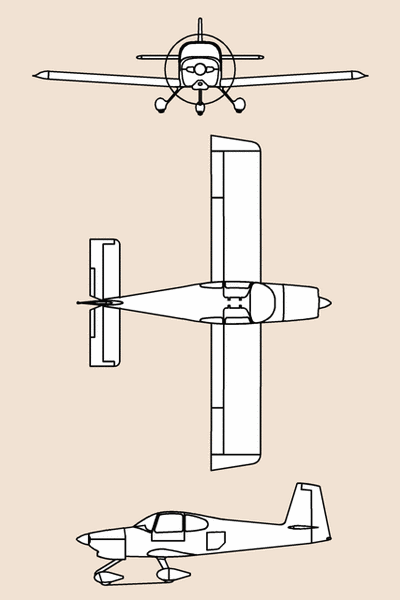Occupants Escape Harm, But Airplane Is A Total Loss
 Here is a tragedy... though we must
note that its a tragedy that could have been FAR worse. The loss of
a carefully crafted Experimental, especially a really prized
airframe like the RV-10, is tragic, but the fact that everyone
survived is a blessing.
Here is a tragedy... though we must
note that its a tragedy that could have been FAR worse. The loss of
a carefully crafted Experimental, especially a really prized
airframe like the RV-10, is tragic, but the fact that everyone
survived is a blessing.
NTSB Identification: ERA10LA256
14 CFR Part 91: General Aviation
Accident occurred Friday, May 07, 2010 in Ridgeland, SC
Aircraft: SWEZEY T/MOLNAR D VANS RV-10, registration: N110TD
Injuries: 2 Serious.
This is preliminary information, subject to change, and may
contain errors. Any errors in this report will be corrected when
the final report has been completed.
On May 7, 2010, about 1511 eastern daylight time, an
experimental amateur-built Vans RV-10, N110TD, was destroyed during
an explosion after landing at Ridgeland Airport (3J1), Ridgeland,
South Carolina. The certificated private pilot and passenger were
seriously injured. Visual meteorological conditions prevailed, and
no flight plan was filed for the personal flight, which was
conducted under the provisions of Title 14 Code of Federal
Regulations Part 91.
According to the pilot, earlier in the day he fueled the
airplane with automotive fuel which contained 10 percent alcohol,
flew to Athens/Ben Epps Airport (AHN), Athens, GA, picked up his
passenger and then departed from AHN about 1400. The flight was
flown at an altitude of 9,500 feet above mean sea level and
everything "seemed normal." While the airplane was on short final,
"about 200 feet from the runway," he had a "brief whiff" of an odor
similar to "a gas smell." Upon landing the passenger asked if they
should open the door and the pilot stated "wait [un]til we clear
the runway." The airplane back taxied on the runway a short
distance and exited the runway on the taxiway adjacent to the ramp
area. As the airplane exited the runway an explosion caused the
windows and door to be blown out. He stated that it was similar to
a "vapor fire" in that there was an intense flash of heat and fire;
however, it did not last long. The occupants exited the airplane.
The pilot returned to the airplane, utilized the on board hand held
fire extinguisher, and extinguished the fire on the floor of the
cabin. As he was walking away from the airplane towards his
passenger, the airplane "exploded" a second time and was engulfed
in flames within moments. The pilot normally "raises the flaps
after clearing the runway;" however, could not recall if he had
raised the flaps just prior to the first explosion.

RV-10 File Photo
According to the co-owner of the airplane it had been inspected
on January 2, 2010 and the "tunnel" for the fuel line was inspected
and free of debris. He stated that normally they use "93 octane
auto fuel;" however, they can use 100 LL aviation fuel. He further
stated that he had flown the airplane about 2 or 3 weeks prior and
did not detect any odors.
Examination of the airplane by Federal Aviation Administration
(FAA) aviation safety inspectors revealed that the airplane was
completely consumed by fire. Only a small portion of the tail
section, and the engine area forward of the firewall had not been
consumed by fire.
The pilot held a private pilot certificate with a rating for
airplane single-engine land and a repair man experimental aircraft
builder certificate with inspection certificate for the accident
airplane. The pilot's most recent FAA third-class medical
certificate was issued in April 2009. During a phone interview with
the NTSB investigator in charge the pilot reported approximately
300 total hours of flight experience and approximately 135 total
hours of flight experience in the accident airplane. He further
reported that his logbook was in the airplane at the time of the
accident.
According to FAA records, the airplane was manufactured and
issued a special airworthiness certificate in 2008. The airplane
was equipped with a Chevrolet 2006 LS-2 engine and a Vesta 3B78
propeller. The pilot reported to the NTSB that during the accident
flight the airplane had just gone over 150 total hours time in
service.

The 1456 recorded weather at Beaufort Marine Corp Air Station
(NBC), Beaufort, South Carolina located 14 nautical miles to the
east of the accident location included winds from 140 degrees at 5
knots, visibility 7 miles, few clouds at 6,000 feet above ground
level, temperature 32 degrees C, dew point 16 degrees C, and the
altimeter setting was 29.98 inches of mercury.
 ANN's Daily Aero-Linx (04.15.24)
ANN's Daily Aero-Linx (04.15.24) Classic Aero-TV: 'No Other Options' -- The Israeli Air Force's Danny Shapira
Classic Aero-TV: 'No Other Options' -- The Israeli Air Force's Danny Shapira Aero-News: Quote of the Day (04.15.24)
Aero-News: Quote of the Day (04.15.24) Airborne 04.16.24: RV Update, Affordable Flying Expo, Diamond Lil
Airborne 04.16.24: RV Update, Affordable Flying Expo, Diamond Lil ANN's Daily Aero-Term (04.16.24): Chart Supplement US
ANN's Daily Aero-Term (04.16.24): Chart Supplement US





